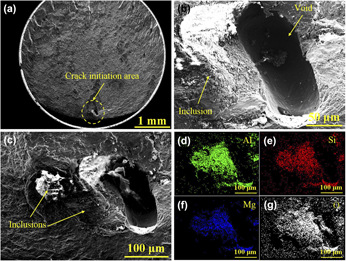Crossref Citations
This article has been cited by the following publications. This list is generated based on data provided by
Crossref.
Shao, Chendong
Lu, Fenggui
Wang, Xiongfei
Ding, Yuming
and
Li, Zhuguo
2017.
Microstructure characterization and HCF fracture mode transition for modified 9Cr-1Mo dissimilarly welded joint at different elevated temperatures.
Journal of Materials Science & Technology,
Vol. 33,
Issue. 12,
p.
1610.
Ding, Kai
Ji, Hui-jun
Liu, Xia
Wang, Peng
Zhang, Quan-liang
Li, Xiao-hong
and
Gao, Yu-lai
2018.
Prevention of carbon migration in 9% Cr/CrMoV dissimilar welded joint by adding tungsten inert gas overlaying layer.
Journal of Iron and Steel Research International,
Vol. 25,
Issue. 8,
p.
847.
Zhang, Wei-Chang
Zhu, Ming-Liang
Wang, Kai
and
Xuan, Fu-Zhen
2018.
Failure mechanisms and design of dissimilar welds of 9%Cr and CrMoV steels up to very high cycle fatigue regime.
International Journal of Fatigue,
Vol. 113,
Issue. ,
p.
367.
Ding, Kai
Wang, Peng
Liu, Xia
Li, Xiaohong
Zhao, Bingge
and
Gao, Yulai
2018.
Formation of Lamellar Carbides in Alloy 617-HAZ and Their Role in the Impact Toughness of Alloy 617/9%Cr Dissimilar Welded Joint.
Journal of Materials Engineering and Performance,
Vol. 27,
Issue. 11,
p.
6027.
Wang, Xiongfei
Shao, Chendong
Liu, Xia
and
Lu, Fenggui
2018.
Transition and fracture shift behavior in LCF test of dissimilar welded joint at elevated temperature.
Journal of Materials Science & Technology,
Vol. 34,
Issue. 4,
p.
720.
Shao, Chendong
Lu, Fenggui
Cui, Haichao
and
Li, Zhuguo
2018.
Characterization of high-gradient welded microstructure and its failure mode in fatigue test.
International Journal of Fatigue,
Vol. 113,
Issue. ,
p.
1.
Ding, Kai
Li, Xiaohong
Zhao, Bingge
Wang, Peng
Ding, Yuming
Lu, Fenggui
and
Gao, Yulai
2020.
Clarification of the false liquation crack existed in 9% Cr/CrMoV dissimilar welded joint by comparative etching process and in situ laser scanning confocal microscope.
Journal of Materials Research and Technology,
Vol. 9,
Issue. 3,
p.
6048.
Zhao, Longfei
Shao, Chendong
Takashima, Yasuhito
Minami, Fumiyoshi
and
Lu, Fenggui
2020.
Numerical Investigation on Fracture Initiation Properties of Interface Crack in Dissimilar Steel Welded Joints.
Chinese Journal of Mechanical Engineering,
Vol. 33,
Issue. 1,
Xu, Ke
Fang, Tao
Zhao, Longfei
Cui, Haichao
and
Lu, Fenggui
2020.
Effect of Trace Element on Microstructure and Fracture Toughness of Weld Metal.
Acta Metallurgica Sinica (English Letters),
Vol. 33,
Issue. 3,
p.
425.
Fang, Tao
Liu, Xia
Shao, Chendong
Cui, Haichao
and
Lu, Fenggui
2020.
Role of tempering cooling rate on impact toughness of 2CrMoV weld metal.
Journal of Materials Research,
Vol. 35,
Issue. 12,
p.
1612.
Wu, Guanzhi
Ding, Kai
Wei, Tao
Liu, Xia
Fan, Manjie
He, Yi
Huo, Xin
and
Gao, Yulai
2022.
Coupled effect of temperature and stress on the microstructure and stress rupture behavior of 9% Cr-CrMoV dissimilar welded joints.
Engineering Failure Analysis,
Vol. 132,
Issue. ,
p.
105945.
Jo, Sumi
Kim, Jung Eun
Kim, Ye Jin
Jin, Sang-Cheol
and
Park, Sung Hyuk
2024.
Enhancing tensile and fatigue properties of high-speed-extruded Mg–5Bi–3Al alloy using non-homogenized extrusion billet.
Journal of Materials Research and Technology,
Vol. 33,
Issue. ,
p.
1436.


